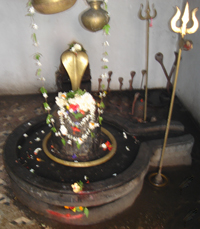History:
No historical record is available about the pristine glory of the great mother goddess Biraja before the great epic the Mahābhārata was written. There is a reference to Virajāh-Tīrtha in the Vanaparva of the Mahābhārata in chapter 85. Moreover the said epic reiterates that the Virajāh-Tīrtha was a sacred place for Vedic sacrifices where Dharma, the God of Righteousness had performed a great sacrifice. During the performance of sacrifice Rudra -Siva is said to have been accepted as an Āryān God by other Gods and the mother Earth had appeared in the form of altar. Therefore, it is but natural that the goddess Earth was worshipped as goddess Biraja of the Virajāh-Tīrtha, Later on. The Ṛgvedic earth goddess was a vaishnavite deity and so became goddess Biraja of the Virajāh-Tīrtha. The Mahābhārata is as old as 7th-6th century B.C. as determined by the scholars. The historicity of goddess Biraja goes back to the days Mother Goddess worship of the Atharva Vedic period i.e. 13th century B.C.
She was originally worshipped in the form of an altar and later on in the form of Stambhesvari (pillar Goddess) as was the primitive practice when carving of stone; metal or wooden images were yet to come about. Most probably she was vindhyavāsinī and Biraja as they named her. During the Gupta rule in India in the 4th century AD, Goddess Biraja was metamorphosed in the theriomorphic form and a stone image of two-armed Mahisāmardinī was installed in a temple after a great Vedic sacrifice beside the river Vaitaraṇī. Since then she is being worshipped on the pedestal as the symbol of paramavaiṣnavī Śakti icon. Simultaneously Nābhigayā, a great Pitṛ Tīrtha, Īśānesvara, lord Varāha and many ancillary deities were added to the Biraja tradition. We are apprised of her greatness from several copper plate grants of Durjaya, Vigraha, Dutta and Maṇa royal dynasties who patronised and revered the deity. During Bhaumakara rule in Odisha she was worshipped as the royal Goddess of the Bhaumakaras. During the Somavansi rule in the 10th -11th century AD, a beautiful temple for Goddess Biraja had been built by Candihār Yayati II. Biraja Kṣetra was made a full-fledged Śakti pīṭha with the association of Aṣṭa Candī, Aṣṭa-Bhairava, Navadurgā, Sapta Matṛkā, Trayodaśa Rudra, Dvādaśa Gaṇeśa, Sixty eight Tīrthas and Causaṭhi Yoginī during Bhaumakara and Somavamsi period. The Somavamsis added a car festival or Rathayātrā with the Biraja tradition like that of the Goddess Vindhyavāsini and Sthambhesvarī of mid-India. Though during the Mughal Afghan rule the Śakti worship relating to Goddess Biraja faced the ups and downs, the tradition continues undeterred till today.
10th -11th century AD, a beautiful temple for Goddess Biraja had been built by Candihār Yayati II. Biraja Kṣetra was made a full-fledged Śakti pīṭha with the association of Aṣṭa Candī, Aṣṭa-Bhairava, Navadurgā, Sapta Matṛkā, Trayodaśa Rudra, Dvādaśa Gaṇeśa, Sixty eight Tīrthas and Causaṭhi Yoginī during Bhaumakara and Somavamsi period. The Somavamsis added a car festival or Rathayātrā with the Biraja tradition like that of the Goddess Vindhyavāsini and Sthambhesvarī of mid-India. Though during the Mughal Afghan rule the Śakti worship relating to Goddess Biraja faced the ups and downs, the tradition continues undeterred till today.
